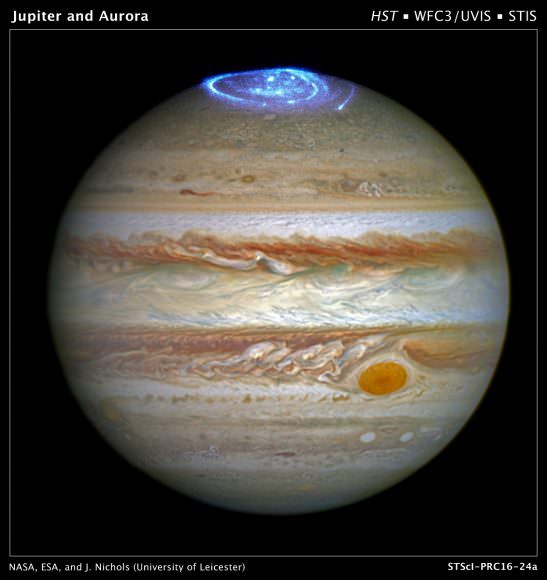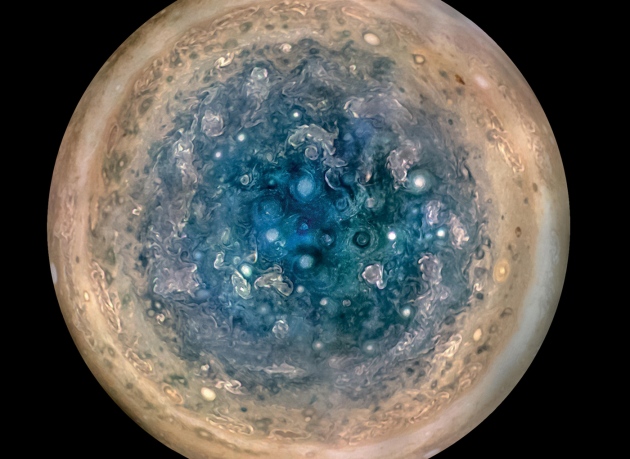In addition to being the largest and most massive planet in our Solar system, Jupiter is also one of its more mysterious bodies. This is certainly apparent when it comes to Jupiter’s powerful auroras, which are similar in some ways to those on Earth. In recent years, astronomers have sought to study patterns in Jupiter’s atmosphere and magnetosphere to explain how aurora activity on this planet works..
For instance, an international team led by researchers from University College London recently combined data from the Juno probe with X-ray observations to discern something interesting about Jupiter’s northern and southern auroras. According to their study, which was published in the current issue of the scientific journal Nature – Jupiter’s intense, Jupiter’s X-ray auroras have been found to pulsate independently of each other.
The study, titled “The independent pulsations of Jupiter’s northern and southern X-ray auroras“, was led by William Richard Dunn – a physicist with the Mullard Space Science Laboratory and The Center for Planetary Science at UCL . The team also consisted of researchers from the Harvard-Smithsonian Center for Astrophysics (CfA), the Southwest Research Institute (SwRI), NASA’s Marshall Space Flight Center, the Jet Propulsion Laboratory, and multiple research institutions.

As already noted, Jupiter’s auroras are somewhat similar to Earth’s, in that they are also the result of charged particles from the Sun (aka. “solar wind”) interacting with Jupiter’s magnetic field. Because of the way Jupiter and Earth’s magnetic fields are structured, these particles are channeled to the northern and southern polar regions, where they become ionized in the atmosphere. This results in a beautiful light display that can be seen from space.
In the past, auroras have been spotted around Jupiter’s poles by NASA’s Chandra X-ray Observatory and by the Hubble Space Telescope. Investigating this phenomena and the mechanisms behind it has also been one of the goals of the Juno mission, which is currently in an ideal position to study Jupiter’s poles. With every orbit the probe makes, it passes from one of Jupiter’s poles to the other – a maneuver known as a perijove.
For the sake of their study, Dr. Dunn and his team were forced to consult data from the ESA’s XMM-Newton and NASA’s Chandra X-ray observatories. This is due to the fact that while it has already acquired magnificent images and data on Jupiter’s atmosphere, the Juno probe does not have an X-ray instrument aboard. Once they examined the X-ray data, Dr. Dunn and his team noticed a difference between Jupiter’s northern and southern auroras.
Whereas the X-ray emissions at the north pole were erratic, increasing and decreasing in brightness, the ones at the south pole consistently pulsed once every 11 minutes. Basically, the auroras happened independently of each other, which is different from how auroras on Earth behave – i.e. mirroring each other in terms of their activity. As Dr. Dunn explained in a recent UCL press release:
“We didn’t expect to see Jupiter’s X-ray hot spots pulsing independently as we thought their activity would be coordinated through the planet’s magnetic field. We need to study this further to develop ideas for how Jupiter produces its X-ray aurora and NASA’s Juno mission is really important for this.”
The X-ray observations were conducted between May and June of 2016 and March of 2017. Using these, the team produced maps of Jupiter’s X-ray emissions and identified hot spots at each pole. The hot spots cover an area that is larger than the surface area of Earth. By studying them, Dr. Dunn and his colleagues were able to identify patterns of behavior which indicated that they behaved differently from each other.
Naturally, the team was left wondering what could account for this. One possibility they suggest is that Jupiter’s magnetic field lines vibrate, producing waves that carry charged particles towards the poles. The speed and direction of these particles could be subject to change over time, causing them to eventually collide with Jupiter’s atmosphere and generate X-ray pulses.
As Dr Licia Ray, a physicist from Lancaster University and a co-author on the paper, explained:
“The behavior of Jupiter’s X-ray hot spots raises important questions about what processes produce these auroras. We know that a combination of solar wind ions and ions of Oxygen and Sulfur, originally from volcanic explosions from Jupiter’s moon, Io, are involved. However, their relative importance in producing the X-ray emissions is unclear.”
And as Graziella Branduardi-Raymont- a professor from UCL’s Space & Climate Physics department and another co-author on the study – indicated, this research owes its existence to multiple missions. However, it was the perfectly-timed nature of the Juno mission, which has been in operation around Jupiter since July 5th, 2016, that made this study possible.

“What I find particularly captivating in these observations, especially at the time when Juno is making measurements in situ, is the fact that we are able to see both of Jupiter’s poles at once, a rare opportunity that last occurred ten years ago,” he said. “Comparing the behaviours at the two poles allows us to learn much more of the complex magnetic interactions going on in the planet’s environment.”
Looking ahead, Dr. Dunn and his team hope to combine X-ray data from XMM-Newton and Chandra with data collected by Juno in order to gain a better understanding of how X-ray auroras are produced. The team also hopes to keep tracking the activity of Jupiter’s poles for the next two years using X-ray data in conjunction with Juno. In the end, they hope to see if these auroras are commonplace or an unusual event.
“If we can start to connect the X-ray signatures with the physical processes that produce them, then we can use those signatures to understand other bodies across the Universe such as brown dwarfs, exoplanets or maybe even neutron stars,” said Dr. Dunn. “It is a very powerful and important step towards understanding X-rays throughout the Universe and one that we only have while Juno is conducting measurements simultaneously with Chandra and XMM-Newton.”
In the coming decade, the ESA’s proposed JUpiter ICy moons Explorer (JUICE) probe is also expected to provide valuable information on Jupiter’s atmosphere and magnetosphere. Once it arrives in the Jovian system in 2029, it too will observe the planet’s auroras, mainly so that it can study the effect these have on the Galilean Moons (Io, Europa, Ganymede and Callisto).
Further Reading: UCL, ESA, Nature Astronomy


“With every orbit the probe makes, it passes from one of Jupiter’s poles to the other – a maneuver known as a perijove.”
Isn’t perijove just the closest approach to Jupiter, just like perigee is the closest approach to earth?
Great job as usual, Matt. I don’t mean to grammar pick, but I wanted to bring one thing to your attention, which you have repeated many times in past articles. Remember that “it’s” is a contraction–it stands for “it is”. In you first sentence or two above, you mention “…Jupiter is one of it’s more mysterious planets.” If you read it as is, it says “Jupiter is one of it is more mysterious planets”–obviously incorrect. Here, you only need to put in “its”–WITHOUT the apostrophe. Can’t remember which one should go in? Merely try the “it is” and if it sounds fine, it usually is.
BTW, you are my favorite writer here on UT!
Explain? No problem.
Some planets are AC, some planets are DC.
It’s obvious here: Jupiter is AC/DC !